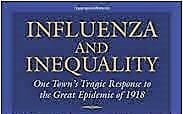
14
SepA Century Later – Norwood’s Experience in the 1918 Flu Epidemic
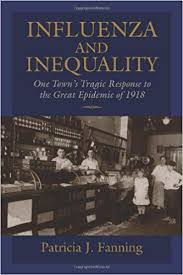 The Black Death (or Bubonic or Great Plague) was a four-year epidemic that affected 30-60% of the European population. It was critical to the history of the Middle Ages that we studied. The Great Plague is believed to have begun in Central Asia in the early 1330s where it was carried by rats on ships across and throughout the Mediterranean and Europe. It is believed to have killed up to 200 million people across Europe from 1347-1351 and it may have taken 200 years before the world’s population recovered from the loss of life from the epidemic.
The Black Death (or Bubonic or Great Plague) was a four-year epidemic that affected 30-60% of the European population. It was critical to the history of the Middle Ages that we studied. The Great Plague is believed to have begun in Central Asia in the early 1330s where it was carried by rats on ships across and throughout the Mediterranean and Europe. It is believed to have killed up to 200 million people across Europe from 1347-1351 and it may have taken 200 years before the world’s population recovered from the loss of life from the epidemic.
Many of us remember studying the Middle Ages and its Black Death in school. What we might not have learned was that there were many plagues throughout history.
The Bubonic Plague reappeared several times again in Europe, but not with the same devastating power. Pulitzer Prize author Geraldine Brooks wrote a startling and heartbreaking account of towns in England suffering from a 1600s plague and its shattering impacts on families, government, and society. The 2001 historical novel, Year of Wonders, is currently in film production.
In 1918, at the end of The Great War (or WWI) the Spanish Flu, or the Pandemic of 1918-1919, affected one-fifth of the entire world’s population. It killed more people than those who had died in the Great War. Somewhere around 20 million to 40 million people died in twelve months.
I don’t remember studying or hearing much about the Spanish Flu in America. Many of my aunts and uncles were alive in 1918 – and certainly my grandparents – and I heard no stories from them during their lifetimes. However, 28% of Americans were affected by the Spanish Flu and more than 675,000 died. The epidemic affected Americans between 20 and 40 years of old the most severely – more than 10 times the soldiers set to return to America from Europe died of the flu than who had died in the war.
Liz Reed, Adult Services Librarian here at our library in Norwood was recently awarded a Massachusetts Humanities Discussion grant to present Norwood’s experience with the pandemic of 1918. A Century Later: Norwood’s Experience in the Great Flu Epidemic of 1918 is a series of 8 events planned throughout the month of October. Several Town of Norwood departments have partnered with the Morrill Memorial Library – the Norwood Public Health Department, the Norwood Highland Cemetery, and the Norwood Senior Center. Also collaborating is the Norwood Historical Society.
Two of the events will focus on books. One was written by Norwood historian and retired professor, Patricia Fanning. Patti Fanning’s book, Influenza and Inequality, began as an academic study of the Town of Norwood’s response to the 1918 epidemic was published in 1910 by the University of Massachusetts. The Historical Journal of Massachusetts writes that “Historians once thought that the pandemic struck down its victims irrespective of class or ethnicity. [Patricia] Fanning dispels this error, demonstrating that immigrants and the poor died in Norwood in disproportionate numbers.”
The other book being discussed during the series, Pale Horse, Pale Rider is a novella by Katherine Anne Porter published in 1939. Porter’s novella depicts the tragedy and suffering in a story of Miranda, a newspaper woman in Denver, Colorado who is tended while sick and delirious from the influenza epidemic of 1918. Adam, a soldier who is also stricken with the flu dies while Miranda is recovering.
The series will begin with a discussion of Porter’s novella at the Day House in Norwood on Tuesday, October 2. Dr. Cashman Kerr Prince, library trustee and member of the Historical Society, will lead the event beginning at 6:30 pm.
On October 10 at 6:30 pm, Dr. Al DeMaria will present A History of Firsts: Public Health in the Commonwealth of Massachusetts. Dr. DeMaria is Medical Director of the Bureau of Infectious Disease and Laboratory Sciences and State Epidemiologist in the Massachusetts Department of Public Health. He is also President of the Massachusetts Infectious Diseases Society. He will lead us on a fascinating journey through the history of public health and disease in Massachusetts.
On Saturday, October 13 between 9 and 11 am, a flu vaccine clinic will be held at the Norwood Senior center. It is open to all residents 14 years or older and the Public Health Department requests that everyone who requests a vaccine bring their health insurance information.
On Monday, October 15 at 6:30 pm at the library, noted historian and author Anthony Sammarco will present Boston 1918: The Spanish Flu. He will lead participants on an exploration of Boston during World War I, the disease that decimated the world, and Boston’s response to the flu epidemic.
On Monday, October 22 at 6:30 pm at the library, author Patti Fanning and library director Charlotte Canelli will lead a discussion of Influenza and Inequality. Ms. Fanning will discuss Norwood’s tragic response to the pandemic that resulted in deaths that occurred in the pockets of Norwood where both the poor and immigrants lived in conditions that both spread the flu and did little to help its victims.
On Saturday, October 27 at 3:00 pm, Patti Fanning will lead a walking tour of Highland Cemetery, the resting place of many Norwood flu epidemic victims. The walk literally illustrates history as the steps of the grieving families and overwhelmed town officials will be retraced. There will be simultaneous flu vaccine clinic on the cemetery grounds courtesy of the Norwood Public Health Department. (Rain date is Sunday, October 28.)
This month-long series will end with the last program on October 29 at 6:30 pm at the library. Influenza 1918, a short documentary film produced by WGBH Boston will be shown. A discussion will follow, tying together personal stories with the historical events.
Registration for these events is available by calling or visiting the library or emailing norprograms@minlib.net. Books for both discussion groups will be available upon registration.
Once the program has ended, book clubs may request the Book Club Kit of Patti Fanning’s book, Influenza and Inequality from the Minuteman Library catalog. Please call the library for more information. We hope you will join us for this very historical, very relevant, very important series!
Charlotte Canelli is the Director of the Morrill Memorial Library in Norwood, Massachusetts. Read Charlotte’s column in the September 13, 2018 edition of the Norwood Transcript and Bulletin.
6
SepPodcast: Not the Same Old Radio Show
![]() Audio blogging, or podcasting, began in the 1980s. It wasn’t until the advent of broadband, mobile applications, and wide use of the Internet, though, that audiobloggers found a niche. Today there are 250,000 podcasts with one billion subscribers on iTunes. In 2004 the word podcast was invented – the word is a blend of the words iPod and broadcast. Podcast is both a noun and a verb. Defined, it is a digital audio file uploaded to the Internet.
Audio blogging, or podcasting, began in the 1980s. It wasn’t until the advent of broadband, mobile applications, and wide use of the Internet, though, that audiobloggers found a niche. Today there are 250,000 podcasts with one billion subscribers on iTunes. In 2004 the word podcast was invented – the word is a blend of the words iPod and broadcast. Podcast is both a noun and a verb. Defined, it is a digital audio file uploaded to the Internet.
I became a podcaster in 2006 after taking a class and uploading my first podcast to Podbean, a free podcast hosting site. My first podcast was a simply a one-episode thing and it was merely an assignment for a workshop I took through our regional library system. A few years later, I began reading and uploading audio versions of our library columns to another hosting service, SoundCloud. It became far too time-consuming and I abandoned the practice, leaving the digital files somewhere in the digital heavens.
So what’s this column about podcasts have to do with the library? While podcasts are free just like public libraries, you don’t need a library card to listen to them. You also don’t listen to them through any library apps. Podcasts aren’t available through our library catalog or digital subscriptions such as Hoopla and Flipster, and you don’t download them through Libby by OverDrive.
As a librarian, and as an enthusiastic podcast subscriber, I simply want you to know (if you don’t already) that a podcast is a beautiful thing. It’s free (mostly). Anyone can create one and upload one with very little equipment (depending on quality). And anyone can listen as long as they have a computer or device that is capable of listening to an audio file.
Podcasts are very much like the radio that some of us grew up with… or some of us didn’t. Beginning in the 1920s and through the 1930s and 1940s, my mother and father and grandparents gathered around the radio to listen to the news, plays, quiz shows and serial episodes. It was the heyday of the radio show. Commercially-sponsored shows, like the Voice of Firestone and Bell Telephone Hour, were weekly addictions. The C.E. Hooper Company measured the ratings of radio during this Golden Age and found that 82 out of 100 Americans listened to radio shows on a regular basis.
During my childhood, we only listened to the radio for the top 100, buying 78s and 45s to play on our record players. Our parents listened to Paul Harvey’s Rest of the Story and Golden Oldies before television took over in popularity through the 50s and 60s. In the 80s and 90s, however, many of us turned to public radio and were hooked on Prairie Home Companion (first aired in 1974 and now called Live from Here without association with Garrison Keillor), Car Talk (first aired in 1977), and This American Life (first aired in 1995). Most radio shows today can be subscribed to as podcasts – downloaded episodes to listen to at our leisure – or listened to in weekly radio broadcasts.
The main difference between a podcast and a radio show is that mainly radio is aired live, unlike podcasts which are recorded and are editable. Just like popular radio shows, successful podcasters have corporate sponsors or are part of the public radio family like National Public Media or local outlets. Some podcasters ask for donations on a website. One of my favorite podcasts asks for memberships, where members only can email questions or get first dibs on listening before the podcast is released.
I was subscribed to a few podcasts in 2014, and listened sporadically, but when the first season of Serial was released in October of that year, I became hooked. Serial was an offshoot of This American Life, a story that morphed into a 12-episode series and totally captured a host of fascinated listeners. The last episode aired in January 2015 when Serial had become a cultural phenomenon and now has been downloaded over one hundred and fifty million times.
Several years after Serial Season One ended, another amazing podcast, S-Town was released. There was no waiting for those of us who binge-listen because it hit the Internet in seven chapters, all at once on March 28, 2017 and within four days it was downloaded 10 million times. It was shocking, sad, poignant and addictive, and it ended far too soon.
As a regular podcast listener and subscriber, I listen to podcasts for education, entertainment and even relaxation. When having difficulty sleeping at night a few years ago, I often listened to Sleep with Me, a boring, monotonous hour-long podcast guaranteed to at least GET you to sleep. Host Scooter (Drew) Ackerman used late-night comedy radio to get to sleep every night. In 2013, he started podcasting “bedtime stories to help grown-ups fall asleep in the deep, dark night.” I can attest to the efficacy of Sleep with Me. However I find his voice maddening sometimes and have given up the habit of sleeping with Scooter Ackerman.
One of my favorite podcasts is Modern Love, produced in collaboration by NPR’s WBUR Boston and the New York Times and released every Thursday. (Host and journalist Meghna Chakrabarti is now also the host of NPR’s On Point, replacing host Tom Ashbrook.) Modern Love essays (from the column in the New York Times and written by professionals and amateurs) are read aloud by amazing actors like Jason Alexander or Sarah Oh. Everyone – writer, actor, Chakrabarti and Daniel Jones, NY Times editor, briefly discuss the essay’s impact and the podcasts typically last 15-20 minutes.
My latest podcast crush is Oligies (first taped in 2017) with actress Alie Ward. In her weekly podcast, Alie Ward discusses another “ology” with an expert in the field. Ferroequinology (study of trains), thanology (death and dying), selachimorphology (sharks) or malacology (snails and slugs are a few of her fascinating subjects. I am constantly amazed at how much I learn about things I never thought I had any interest in.
If you need help figuring out how to listen or subscribe to podcasts on your computers or devices using iTunes, Stitcher or other podcast aggregators, please call the library and make an appointment with one of the librarians who can help you.
Charlotte Canelli is the Director of the Morrill Memorial Library in Norwood, Massachusetts. Read Charlotte’s column in the September 6, 2018 edition of the Norwood Transcript and Bulletin.
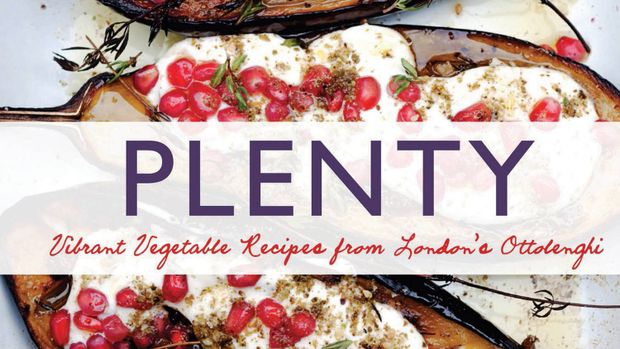
30
AugCook the Book: Falling Back in Love with Cookbooks
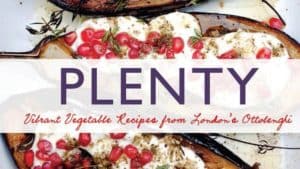 Once upon a time, I was an organized home cook. I planned our weekly menus for our meals at home, shopped for only fresh ingredients weekly, and did all my prep work in the mornings before work. Then I had a baby and all of my careful, well-honed organization went out the window. Gone were the days when I had time to flip through my cookbooks at a leisurely pace. I tried to make meal plans but then a baby wouldn’t stop crying and something would burn or a toddler interrupted me a thousand times before I could dice a shallot. Food shopping became a marathon exercise of half-remembered lists and saying “No, put that down; we don’t need that!”
Once upon a time, I was an organized home cook. I planned our weekly menus for our meals at home, shopped for only fresh ingredients weekly, and did all my prep work in the mornings before work. Then I had a baby and all of my careful, well-honed organization went out the window. Gone were the days when I had time to flip through my cookbooks at a leisurely pace. I tried to make meal plans but then a baby wouldn’t stop crying and something would burn or a toddler interrupted me a thousand times before I could dice a shallot. Food shopping became a marathon exercise of half-remembered lists and saying “No, put that down; we don’t need that!”
Like every aspect of motherhood, there was a learning curve. Feeding my family was essential but I had to figure out how I could get back to my love of cooking instead of just throwing something (rather unhealthy) together while feeling exhausted and underappreciated. One simple change has made a difference: time has passed. I no longer have a baby or a toddler but a nearly self sufficient elementary school aged child who loves to cook herself. My husband arrives home on the later side, so I feed my daughter earlier in the evening and he and I eat after bedtime, leaving me a little time to put something decent together.
I’ve tried several strategies. My first attempt to reawaken the love of cooking was signing up for Blue Apron, a delivery service that provided meal kits to be prepared at home. The recipes looked delicious and the ingredients were extremely fresh but I soon experienced a few downfalls. First of all, I couldn’t choose what meals would arrive in a given week. Some people like that type of variety, but I suppose I’m more of a creature of habit than I realized. I like to look forward to things, even meals. Secondly, many of the recipes had steps I deemed unnecessary. I remember angrily shelling edamame and thinking, “But I could have bought shelled edamame to begin with and saved time!” I have a decent amount of experience in the kitchen, and I automatically scan recipes to see how I can streamline steps to maximize my time. One of my key time savers is buying produce already prepared and ready to use.
Blue Apron didn’t last long and I had already set my sights on switching to Plated, another meal kit delivery service that allowed us to pick from thirteen recipes each week. I solved my first problem by giving myself more control over what we received each week. I also found that Plated recipes required less fuss with ingredient preparation. We had a few issues with the actual delivery that led us to cancel the service so I was back at square one with meal planning.
Now that my daughter is a little older, I’m feeling the tug towards my long-neglected cookbook collection. Since discovering a new delivery service through Amazon called Prime Now, I’m starting to entertain the idea of going back to traditional meal planning with an updated food shopping service. Simply create a shopping list on your Prime Now app and someone will shop FOR you at Whole Foods and then deliver the grocery order to your house. No more wrangling a cranky child and an unwieldy shopping cart. That freedom has helped me rediscover some of my old favorite recipes from the dusty cookbooks on my shelves.
Plenty by Yotam Ottolenghi was my first foray into non-traditional vegetarian cooking. Ottolenghi is a well-regarded British chef, restaurateur, and column writer for The Guardian. His philosophy about cooking vegetables made complete sense to me after I read an interview where he described the importance of recipes highlighting the flavor and properties of a vegetable, not trying to sell it as a meat substitute. Plenty takes this approach and does not pretend to try and turn hardcore meat eaters to veganism. It’s simply a great cookbook if you want interesting vegetable dishes that shine. My personal favorite recipes include Very Full Tart, Smoky Frittata, and Caramelized Fennel with Goat Cheese. My one recommendation with this cookbook is to watch cooking temperatures and time. I suspect Ottolenghi used his commercial grade kitchen when perfecting his recipes rather than a residential one and often food takes longer than he says it should.
On the opposite end of the cooking spectrum is Ina Garten, who probably needs no introduction. In case you have been living under a rock, Ina is a world famous Food Network host, chef, and former owner of the Barefoot Contessa shop in the Hamptons of Long Island. While some find her New York charm and insistence on “good” ingredients a little grating, I love that Ina never compromises on what’s important to her. The Barefoot Contessa: Back to Basics is filled with simple, tasty recipes and easy instructions. Ina is a home cook, so all of her recipes are usually very accurate and easy to make. Favorites like her Chicken Bouillabaisse take me back to a time before motherhood when I could spend several hours cooking every night and still remains my “date night in” specialty.
Now that fall is on the horizon, I find myself flipping through Molly Stevens’ classic Roasting. The oven is my secret weapon for mom-friendly recipes. I can quickly marinate or season a piece of meat with pre-chopped veggies while it preheats, and then walk away while everything roasts for 40 minutes. The house fills up with a delicious scent and I really feel as if I’ve made a good effort in the kitchen. Roasting is a master class in this, and Stevens’ chatty and detailed chapter introductions really help you master a technique rather than just one dish. When the cooler weather arrives, I love the comfort food appeal of Roasted Chicken Pieces Dijonnaise.
These three are only a few of my treasured collection! I’ve downsized a bit after several moves and have really only kept the cookbooks that contain recipes and techniques I truly love and use. I’m always on the hunt for new, tasty looking and well-written recipes, and frequently rifle through the library’s new nonfiction to see the latest cookbooks. I also love to wander in the library’s infamous “cookbook aisle” in the 600s on the mezzanine level. We have an unbelievable collection that could pull any home cook out of a slump.
Kate Tigue is the Head of Youth Services at the Morrill Memorial Library in Norwood, MA. Read Kate’s column in the August 30, 2018 edition of the Norwood Transcript and Bulletin.
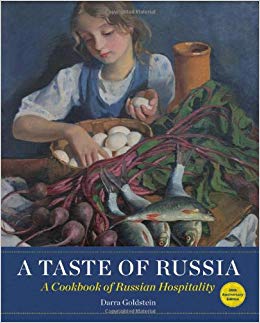
23
AugBinging on Great British Baking and Russian Pastry
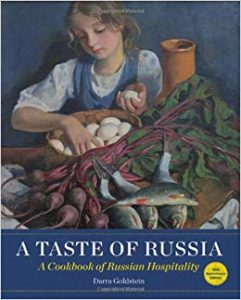 Gerry and I binge-watched at least four seasons of the Great British Baking Show this summer. It had been recommended and once I started binging and proselytizing about my new-found crush, I realized that, as with most other hit series, I was years late to the party. Especially this British one.
Gerry and I binge-watched at least four seasons of the Great British Baking Show this summer. It had been recommended and once I started binging and proselytizing about my new-found crush, I realized that, as with most other hit series, I was years late to the party. Especially this British one.
During one particular B-A-A-A-A-K-E which happened to be pastries, I thought of the favorite savory pastry that had captured my fancy over 25 years ago. It was the kulebiaka (or coulibiac) – a time-consuming Russian first course. The kulebiaka boasts a flaky, buttery pastry that envelopes a filling of either cabbage and chopped hardboiled eggs or salmon, rice and dill. My finished kulebiaka’s crust is garnished with leaves and a rope closure and rises and bakes to golden perfection.
Once sliced and served with sour cream, it is always met with ooohs and aaaahs across the room. Anton Chekhov wrote in his short story The Siren that “the kulebiaka must make your mouth water; it must lie there before you, a shameless temptation! You cut off a sizable slice and let your fingers play over it. When you bite into it, the butter drips from it like tears.”
I fantasized, recently of course, that Paul Hollywood would have swooned over one of my masterpieces, the kulebiaka. I might have had a handshake.
Long before I was awarded my master’s degree in library science (or MLS) from Boston’s Simmons College, I had returned to college in the late 1980s as an undergraduate. Years earlier I had left behind three years of academic work in History and Political Science at a California university to begin raising my family. A requirement for completing my degree with distinction from a Massachusetts state college was that I must complete more than half of the total required credits (120) at a Massachusetts school. Doing the easy math, I need to complete 150 total credits instead of the normal 120 for a bachelor’s degree. Lucky for me, I had more curiosity than 120 credits anyway.
My favorite courses that second time around were in Russian Studies, which of course fell right smack within my favorite academic areas of interest: history, literature and political science. For a minor in Russian Studies I was also required to take at least a year of Russian language and I memorized the Cyrillic alphabet forwards and backwards. My studies included a tour to the Soviet Union in 1990, a year before my hero USSR President Mikhail Gorbachev’s policies of glasnost and perestroika helped to dismantle the Soviet Union and communism.
My interest in Russia started many years before… as a very young child. Moving to Berkeley, California at the age of six, my family rented an apartment in a big house just three houses from my new elementary school. Our absent landlady was a large, hardy and hearty block of a Russian woman who was missing most of her right arm. Her infrequent visits, her Russian accent, and her exotic right arm fascinated me. That curiosity led me to other things Russian in my youth, including a book I read my senior year in high school, We the Living by Ayn Rand. It is one I credit with many influences in my life. The young, female protagonist in the book is named Kira. It was years later, after naming my youngest daughter with the Irish version of that name (Ciara and pronounced exactly the same), when I realized just how influential the book had been.
Returning from the study tour in the Soviet Union in 1990, I took up Russian cooking with an energetic passion. My graduation party from college in 1991 was a huge affair with over a hundred friends and family feasting on Russian food and drink. I enlisted the help of some of those friends who cooked and baked with me all week. I rented tables for the backyard and placed centerpieces of pitchers of lilacs, all donated from another friend’s garden. I hired a young Russian man named Sasha who appeared dressed in traditional Slavic costume. He spent the afternoon roaming the yard with his balalaika and entertaining the crowd with lovely Russian folk music. In addition, I contracted a slick-suited pianist named Vladimir who played music by Russian composers on the piano in my living room. It was a tremendously wonderful party and I smile again remembering it nearly three decades later.
So, following that pastry episode on the GBBS, I searched for my recipe books and came across some of my old favorites on my bookshelves, A La Russe: A Cookbook of Russian Hospitality by Darra Goldstein and the Art of Russian Cuisine by Anne Volokh. The copy of my favorite book, Russian Cooking, part of the Time-Life Cooking of the World Series I had collected in the 70s as a young wife, was missing. That book was the one from which I’d learned exactly how to assemble the kulebiaka, using the photographs over a two-page spread. To my surprise, not one of the Minuteman Libraries had a copy. Thankfully, I found over a dozen copies of Russian Cooking listed in the Massachusetts’ Commonwealth Catalog (or ComCat.) Although I could have requested one through Massachusetts library delivery, I eventually unearthed my own copy. I discovered the very worn and stained spiral-bound book of recipes and the accompanying hardcover in my basement, mixed in with a few other castaways.
Searching the library catalog, I found a more recent copy of Darra Goldstein’s book (published in 2013 as A Taste of Russia and I’ve added to our collection.) Her book is rich with recipes for Marinated Mushrooms, Baked Apple Charlotte, Baba au Rhum, and Siberian Dumplings. The recipe for Apricot Tart is one I memorized 25 years ago and use over and over again. Anne Volikh’s Art of Russian Cuisine is no longer in print, but several libraries have it on their shelves. She also includes a page of drawings illustrating assembly of the Kulebiaka and recipes from across the huge Russian and Soviet empires. Our library has a copy of Please to the Table by Anya von Kremen that includes recipes across the fifteen former republics of the Soviet Union.
If you’d like to learn the art and passion of Russian cooking, like the famed kulebiaka, there are many books in the Minuteman Library Network and across Massachusetts through ComCat. Or watch every episode of the Great British Baking Show and save those calories.
Charlotte Canelli is the Director of the Morrill Memorial Library in Norwood, Massachusetts. Read Charlotte’s column in the August 23, 2018 edition of the Norwood Transcript and Bulletin.

17
AugAnne of Green Gables: A Short Bit About Adopting an Older Child
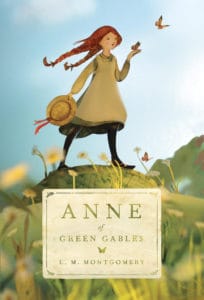 I fell in love with Anne of Green Gables while in college. I never read the books in high school, dismissing them because of the romance-y looking covers. I quickly realized my mistake and have read the series several times. I have visited Anne’s beloved Prince Edward Island, Canada. I attended the Anne play in Charlottetown, and was in heaven as I sat with my fellow Anne-fans, finishing up with a raspberry cordial at a nearby restaurant.
I fell in love with Anne of Green Gables while in college. I never read the books in high school, dismissing them because of the romance-y looking covers. I quickly realized my mistake and have read the series several times. I have visited Anne’s beloved Prince Edward Island, Canada. I attended the Anne play in Charlottetown, and was in heaven as I sat with my fellow Anne-fans, finishing up with a raspberry cordial at a nearby restaurant.
A mother and daughter were seated next to us, and the girl, probably about 14, was making it quite obvious that she didn’t want to be there and that the whole thing was “stupid.” Her poor mother finally had her moment when Anne’s beloved adopted guardian Matthew died suddenly of a heart attack. Soon, there were sniffles all around, and the young girl, ready to roast her mother, looked around, and sat back, quietly. I think she must have finally realized that hey, my mom’s not crazy. This is a thing; this Anne of Green Gables.
I relate this story because I remember thinking at the time, “of course my daughter will love all things Anne, especially if she’s adopted.” My husband and I had always toyed with the idea of adopting, knowing that there are so many children out there waiting for families. After having struggled with fertility issues for many years, we decided to adopt. If the child was a girl, she would probably be a lot like Anne; love books, have a great imagination, maybe get into a few scrapes here and there, but have a good heart and a great capacity to give and receive love.
Fast forward about 5 years… my husband receives a call from his great-aunt… “I know someone who has a little girl who is looking for a family.” This girl, who was just 6 years old, had been left by her birth mother at 2 years with a man who wasn’t her bio-dad and was now dying of Parkinson’s. It was an emergency situation; the man’s ex-sister-in-law (our introduction to the complex relationships involved with adoption) was anxious to find a place for her; the child was currently living with them. We hired a social worker and a lawyer, and began preparing for a child to move in with us.
We had just moved from a studio apartment to our first home, a 2 bedroom townhouse. In addition, this sister-in-law happened to live in the same town, so the little girl, who was attending Kindergarten, wouldn’t have to change schools. It seemed like an ideal situation: a couple desperately wanting to be parents, and a child who desperately needed a family. We began visiting with her and having her visit us. A pixie of a child, with huge blue eyes and close-cropped hair, she was adorable. She had a huge, toothy smile. She wanted to call us “Mom and Dad” right away. After a few months of visits and overnights, we took the big step and had her move in with us.
As we dealt with the lawyer, social worker, and adoption agency, we had to deal with something which, for me, was even bigger… my preconceived notions of adoption and parenting. The little girl was welcomed into our home and she seemed to feel comfortable there immediately, claiming this and that as “hers,” and generally making herself at home. My expectations of my adopted child being like Anne Shirley… an avid reader (like myself), a great imagination, a propensity for getting into scrapes, with a good heart and a great capacity to give and receive love, like the orphan starved for love that she was, were about to be challenged.
In Anne of Green Gables, Anne Shirley also made herself very comfortable when she first met Matthew and subsequently Marilla. She had her own gable room. Anne Shirley came with her own last name, as did Our Anne. She loathed and hated her red, red hair… hair that was to torment her throughout adolescence. Our Anne had extremely thick, curly hair which continues to torment her to this day, but which I personally think is beautiful. Like Anne Shirley, Our Anne had a vivid imagination… and like Anne Shirley in the scene where she is “confessing” to Marilla that she has lost Marilla’s precious brooch, Our Anne caused herself (and her parents) a lot of trouble with half-truths, fantasies, and outright fabrications. Our Anne’s “confessions” always seemed to be heard by someone in power (teacher, principal, etc.) and were always duly investigated. We had a rather strained but working relationship with the elementary school Our Anne was attending.
Our Anne had as much a capacity for getting into trouble as Anne Shirley did. The only difference is, Our Anne’s “scrapes” tended to be more like lesions… whatever she did was done wholeheartedly. There were bullying incidents, stealing incidents, and lots of behavioral incidents as this child tried to make her way in her new life. As an educator for over 20 years, I developed a very healthy respect for parents and the job of parenting. After some time, I also realized that I was being gifted with a unique perspective. Going through my daughter’s struggles with her gave me more understanding for the plight of adopted children in both their families and in classroom settings.
As much as Anne Shirley loved reading, our daughter despised it. We read to her every night (which she liked well enough) but our attempts to interest her in reading for its own sake were futile. I tried to convince her that reading would open up a whole new world for her… but, like Anne Shirley, Our Anne has her own mind and that mind was made up… books were “dust.” Sigh!
Anne Shirley was a love-starved child, as was Our Anne. However, their reactions to this issue were quite different. Anne Shirley was friendly, open and ready to love and be loved. Our daughter struggled to touch or be touched in any way, and didn’t know how to receive our love. This was such a tough thing to deal with, as I am an affectionate person. I had to satisfy my urge for affection with a pat on the shoulder or, most often, words of approbation.
Ten years later, our girl still struggles with some of these issues, and some new ones that keep cropping up. In the Anne of Green Gables series, Anne Shirley had some traumatic experiences that we know about, and probably some that we don’t. Our daughter had a truly traumatic early childhood and, to be expected, bears the scars to this day.
Adopting an older child taught me many valuable things: differences don’t have to sever us, we can both accept each other and celebrate our strengths, love is an action word… and it is not always easy to carry out, especially when it falls on deaf ears, the change in myself is as remarkable as the change in my daughter… I am much lighter on the preconceived notions and far more accepting of things as they come. And I have her to thank for that!
Recommended Reading:
Twenty Things Adopted Kids Wish Their Adoptive Parents Knew, by Sherrie Eldridge
The Post-Adoption Blues: Overcoming the Unforeseen Challenges of Adoption, by Karen J. Foli Ph.D. and John R. Thompson M.D.
Carla Howard is the Senior Circulation Assistant/Marketing and Media Assistant at the Morrill Memorial Library in Norwood, MA. Read Carla’s column in the August 16th issue of the Norwood Transcript and Bulletin.
